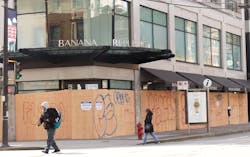Retailers are confronting unprecedented business and protection risks over the next twelve months. Loss Prevention leadership will be challenged like never before. What has worked won’t necessarily work going forward. The challenges will be formidable as they will be unique. We will discuss some of the more pressing issues facing the retail sector in the coming months and how loss prevention professionals will address them.
Organized Retail Crime (ORC): Theft and Fraud
ORC will increase exponentially in the last two quarters of 2020 and throughout all of 2021. In 2019 retail theft and fraud cost U.S retailers $62B, up from $51B the previous year, according to the National Retail Federation based on a survey they conducted earlier this year. A shift from brick and mortar theft and fraud to e-commerce and supply chain fraud was unprecedented this past spring. Most retailers were not open except those classified as “essential”. And those retailers experienced increases of ORC in individual stores. Because more thieves visited fewer stores due to two old axioms: risk vs. reward and supply vs. demand.
With more retailers declaring bankruptcy and going out of business and others closing less profitable stores, there are fewer locations where thieves can ply their trade. Retailers remaining will be more vulnerable to losses unless they “harden their sites” by using technology such as artificially intelligent video systems and AI and TI enhanced intelligence software driving determined thieves elsewhere.
Other factors to be considered in the anticipated increase in ORC activity through the balance of 2020 and through 2021:
- Due to COVID-19, many prisons across the country have released inmates into society again. The only life experiences they may have to entice many of these now former prisoners back into active theft and fraud, causing the population of likely causes of theft and fraud to balloon.
- Unemployment increases results in a higher degree of desperation among the populace. Desperation makes it easier for some to rationalize committing acts of theft and fraud.
- Reduction in Law Enforcement officers due to socially driven budget impacts will result in policy changes regarding police response. Also affecting response will be a subtle reluctance on the part of some officers to ‘get involved’.
- Changes in adjudication limits increasing the levels of theft and fraud that prosecutors will pursue. Also, the elimination of bails in some jurisdictions places many chronic offenders right back out on the streets immediately after arrests.
Law Enforcement Response to Retailers’ Needs
Many law enforcement departments are experiencing defunding demands. In some extreme situations, city governments have actually eliminated police departments from their cities. Sometimes, the city fathers have replaced sworn, armed officers with unarmed private security that have very limited enforcement powers and, frankly, are not properly trained. The urban civil unrest after-action has resulted in a severe tightening of the budgetary purse strings with a resulting limitation on the duties of law enforcement officers.
Retailers need to know by individual store location what the local police department and prosecution rules are and set aligned expectations. Store Policies and procedures need to conform to local jurisdiction rules and capabilities. Frequently, this will create changes in loss prevention practices on a store-by-store basis, making management oversight even more challenging than it has been historically.
Premises ‘safeness’ is ultimately the responsibility of the retailer, perhaps in coordination with mall management. Graffiti, litter, unrepaired and neglected damaged property frequently leads to parking lot loiterers and panhandling, auto theft and strong-armed robbery. Patrols by law enforcement will be limited if at all.
All too frequently we have experienced accelerated civil unrest in which both protesters and bystanders are placed in very dangerous situations. Anarchists driving some of this activity have little regard for personal safety and obviously none at all for property. Frequently, their goal is to damage or destroy what businesses have worked hard to create. Retailers must have contingency plans in place and practiced in order to recover quickly from these disruptions. Usually, these initiatives are led by loss prevention or risk management.
Included in these contingency plans should be actions to take in the event of a protest “attack” on an executive’s home or in a public place. A proactive approach to mitigate these threats is to have a social media monitoring function to develop intelligence. Proper analysis of this information can enable senior management to make calculated decisions to protect lives and property and anticipate a lack of or slow response from law enforcement.
According to some experts, another global pandemic is likely to occur within the next six months. Taking lessons learned from this year’s pandemic to implement recurring business plans is a group effort by management from several internal functional areas which will result in less loss of business and greater safety for customers and employees.
Physical Security Capital and Human Resources Needs
As support from law enforcement declines, the retailer must step-up the resources required to fill the resulting gaps. Expectations from senior management for loss prevention leadership, operations and results will increase, or at least they should. Frequently, it is the responsibility of loss prevention leadership to educate and sensitize senior management as to the plans of action required and why cost justification and the risks of not supporting a well thought out program.
In 2019, the Retail Industry Leaders Association (RILA) published an outstanding report compiled and presented by Adrian Beck, an Emeritus Professor at the University of Leicester, UK, former Chair of the Department of Criminology. The report, entitled Total Retail Loss 2.0, From Theory to Practice is an excellent primer for retailer senior management and a great reference document for practitioners in loss prevention leadership roles. It is strongly recommended that retailers across America become intimately familiar with this report. Contact RILA (www.rila.org) for copies of this report.
Utilizing resources like this and other highly regarded sources such as the Loss Prevention Research Council at the University of Florida is a critical step in understanding this important functional area within the retail enterprise. Understanding the loss prevention business on a global practice basis, understanding what generally accepted practices are and understanding the specific retailers’ business in detail is also critical to the success of the loss prevention practice. This is not to say that the mold cannot be broken. In fact, it should be if it doesn’t fit with the retailers’ business and its limitations or advancing technological trends which may dictate a different but better way of achieving results.
TechRepublic published an article in July 2020, citing the demand for video surveillance cameras to jump from $23.6B in 2019 to $44B in 2025, a compound annual growth rate of almost 13%. The possible caveat which may hamper that growth is the increasing sensitivity of advanced analytics and artificial intelligence for applications like facial recognition which may lead to greater regulation of these devices. But preparing for that possibility is the responsibility of the loss prevention leader who wants state-of-the-art deterrence and detection capabilities for their retailer employer.
A big area of opportunity for emerging technology in loss prevention efforts is within the critical function of the supply chain. Theft and fraud in the retail supply chain have a direct impact on revenues and profits for every retailer. Technology solutions providers would be well-served to understand this component of the retail business and create technological solutions that would serve multi-purposed objectives related to security and to efficiencies and accuracy.
COVID-19 Impact 0n Retailers
It is difficult to forecast with any degree of certainty whether customers will return to stores as more and more brick and mortar locations re-open their doors. Some experts believe that mall-based stores will fare less well than freestanding, standalone locations. Sarah Wyeth, S&P Global, recently said in an interview that retailers tied to enclosed malls have the most to lose (investors beware). This would include Macy’s, Nordstrom and others. JCPenney, Sears and Nieman Marcus were in trouble before the pandemic began but COVID-19 put the proverbial nail in the coffin. Smaller box retailers like Pier 1 Imports were already in trouble as well.
Moody’s says the retail industry remains under extreme stress and operating income for the industry will likely fall by as much as 30% for 2020 without a return to pre-pandemic operating profits until at least 2022. And even then, the recovery will be unstable based on the retail niche.
All of this leads to reduced customer traffic and reductions in sales revenues. This financial impact may have a significant negative impact on the loss prevention leader who has not developed a good relationship with his or her employer’s senior management. Obtaining capital and human resource budget allocation is going to be very challenging. The LP leader will need to solicit a lot of internal partners in the development of a comprehensive plan to protect assets this Fall and through next year. Anticipate addressing needs like extra shopping assistance help, those lesser paid associates who fetch product for customers and generally help the regular sales staff and bringing on extra help who work within the supply chain. All of these temporary part-timers create more challenges for loss prevention personnel.
As discussed previously, theft and fraud are expected to look like a hockey stick -- with a steep vertical trajectory for the rest of the year and into 2021. Successful LP departments will have a good proactive program in place designed to impact losses, protect customers and employees and will have early results in limiting loss and increasing safeness.
Tension, Desperation and Anger
There is a large percentage of the U.S. population who is very disgruntled, have short fuses, feel misled by politicians and governments, are tired of being pent up and feeling like they are no longer making the contribution that they did previously. Consequently, their frustration leads to hostility towards others and low tolerance for rules.
Resistance to mask-wearing edicts is an example. Customers reacting negatively when approached by store staff who request them to “mask up”, customers attacking other customers for non-compliance to wearing masks and an extraordinary willingness to bend the rules whenever and wherever they can are examples of this pent up frustration.
State OSHA Departments are trying to hold retailers accountable to enforce mask compliance and retailers are pushing back. As stated previously law enforcement is unable or unwilling to enforce mask compliance. So, who will wade into the fray and enforce the rules? And how?
Emotions from the frustrations that much of the populace is feeling are manifested in anger. There is customer-to-customer anger, customer to employee and vice versa anger, domestic spillover anger and a lot of anger that frequently results in violence.
An immediate priority for retailers is to develop, deliver and reinforce de-escalation training. Engage an expert to craft the correct training program applicable to the specific retailer’s business. Be sure all staff members are educated in what is acceptable behavior in the workplace.
About the author: King Rogers was Vice President of Assets Protection at Target Corporation for almost 18 years and has been a successful entrepreneur since 2001 when he retired with the intent of bringing his successful experience to the broader industry. In partnership with several other practitioners/leaders, King started, grew and sold two successful advisory services firms, KRI and KRG. Both companies capitalized on leveraging the knowledge of the Founders who understood the application of forward-thinking technology and the value of meaningful intelligence in making a measurable impact in permanently reducing loss.
King's background encompasses over 40 years in the security and loss prevention field as well as early experience in a government intelligence agency. In addition, King was instrumental in the development of the Criminal Justice Long Distance Learning Graduate program at Michigan State University and was a co-founder of the Loss Prevention Research Council (LPRC) at the University of Florida. He was also one of the first inductees in the National Retail Federation's Loss Prevention Ring of Excellence.


